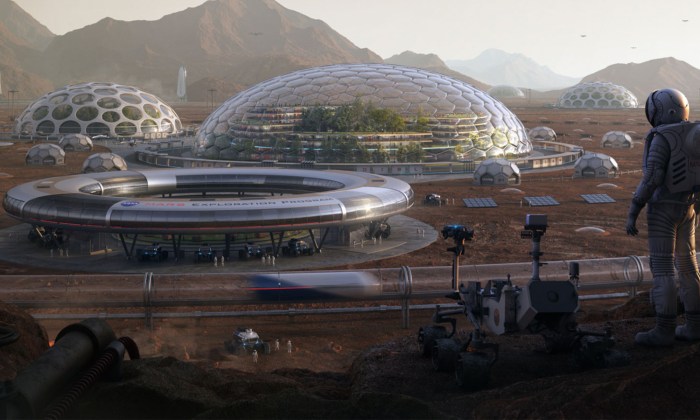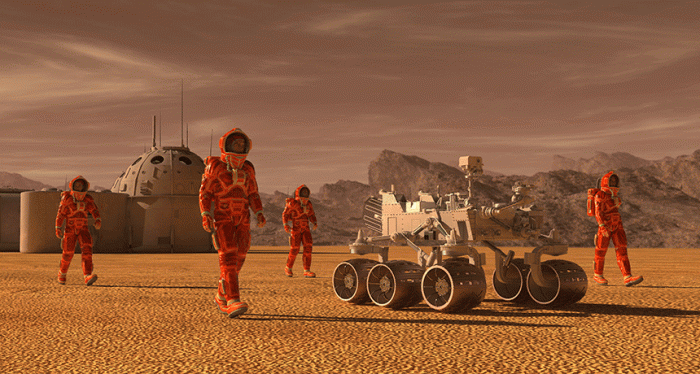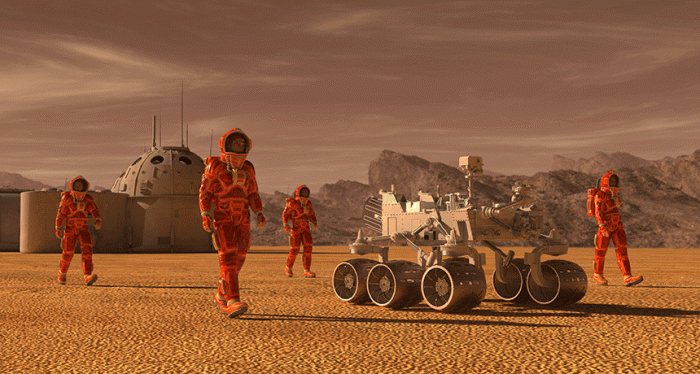Space engineer life on Mars is not just a dream, it’s a reality waiting to be built. Imagine a world where you’re not just an engineer, you’re a pioneer, a builder of the first Martian settlements. The challenges are immense: a thin atmosphere, extreme temperature swings, and a desolate landscape.
But the opportunities are even greater. We’re talking about building habitats, extracting resources, and creating a self-sustaining colony on another planet.
This isn’t just about science fiction, it’s about the future of humanity. The challenges of Martian engineering are pushing the boundaries of our knowledge and technology, forcing us to innovate in ways we never thought possible. We’re talking about 3D printing entire structures, utilizing Martian resources for fuel and building materials, and even developing new life support systems to keep humans alive in this harsh environment.
The Martian Frontier
Standing on the desolate, rusty-red surface of Mars, gazing at the thin atmosphere and the vast, seemingly endless expanse of the landscape, one can’t help but feel a sense of awe and a profound understanding of the immense challenge that lies ahead.
As a space engineer, the Martian frontier presents a unique set of challenges and opportunities, demanding ingenuity, resilience, and a deep understanding of the harsh realities of this alien world.
Harsh Martian Environment
Mars’s environment is unforgiving, posing significant hurdles for any human presence. Its thin atmosphere, composed primarily of carbon dioxide, offers little protection from the Sun’s harmful radiation. The atmospheric pressure is only about 1% of Earth’s, making it impossible for liquid water to exist on the surface.
Mars experiences extreme temperature fluctuations, ranging from200°F (-129°C) at night to 70°F (21°C) during the day. This harsh environment necessitates advanced engineering solutions to ensure the survival and well-being of future Martian colonists.
Building the Martian Infrastructure
Establishing a permanent human presence on Mars requires a robust infrastructure that can support life, research, and future expansion. This necessitates a multifaceted approach, with space engineers playing a pivotal role in designing and constructing essential facilities.
Habitat Construction
The Martian environment poses unique challenges for habitat construction, demanding materials and structures capable of withstanding extreme temperatures, radiation, and low atmospheric pressure.
Discover more by delving into uk leading generative ai lawtech further.
Material Selection
- In-situ resource utilization (ISRU):Utilizing Martian resources like regolith (soil) for construction materials is crucial to reduce the cost and complexity of transporting materials from Earth. Regolith can be processed into concrete-like composites using techniques like 3D printing, providing a sustainable and locally sourced construction material.
- Inflatable modules:Lightweight and easily deployable, inflatable modules offer a rapid and cost-effective solution for creating habitable spaces. They can be made from durable, radiation-resistant materials and inflated on-site, providing flexible and expandable living quarters.
- Composite materials:Combining the strength of metal with the lightweight properties of polymers, composite materials like fiberglass and carbon fiber are ideal for structural elements and pressure vessels. These materials offer a balance of strength, weight, and durability, making them suitable for Martian applications.
Structural Integrity
- Pressure vessels:Martian habitats require airtight pressure vessels to maintain a breathable atmosphere. These vessels must be designed to withstand the pressure differential between the internal environment and the thin Martian atmosphere. This involves meticulous engineering to ensure structural integrity and prevent leaks.
- Radiation shielding:Mars lacks a protective magnetic field, exposing habitats to harmful cosmic radiation. Radiation shielding is essential for protecting inhabitants. This can be achieved through layers of dense materials like concrete, water, or even regolith, strategically placed around the habitat.
- Seismic stability:Mars experiences seismic activity, albeit less frequent and intense than on Earth. Habitat structures must be designed to withstand potential tremors, using techniques like base isolation or flexible connections to absorb ground motion.
Resource Extraction, Space engineer life on mars
Extracting resources from Mars is crucial for sustaining a human presence, including water, minerals, and potential fuels.
Water Extraction
- Subsurface ice:Evidence suggests the presence of significant water ice deposits at the Martian poles and beneath the surface. Space engineers are developing technologies to extract this ice, using techniques like thermal drilling or sublimation, to provide a vital resource for drinking, agriculture, and rocket fuel production.
- Atmospheric moisture:While the Martian atmosphere is thin, it contains trace amounts of water vapor. Engineers are exploring technologies like moisture condensers to extract this water, albeit in limited quantities, as a supplementary source.
Mineral Extraction
- Regolith mining:Regolith, the Martian soil, contains various minerals, including iron, titanium, and silica. Extracting these minerals can provide building materials, raw materials for manufacturing, and even potential resources for producing rocket fuel.
- Deep-sea mining:Recent discoveries suggest the potential for mineral-rich deposits in the Martian subsurface. Developing technologies for deep-sea mining on Earth could be adapted to extract these resources, unlocking valuable resources for future Martian development.
Power Generation
Reliable and sustainable power generation is critical for operating Martian habitats, research facilities, and transportation systems.
Solar Power
- Photovoltaic panels:Solar panels are a proven technology for generating power on Mars, leveraging the abundant sunlight. However, dust storms can significantly reduce efficiency, necessitating advanced cleaning mechanisms and backup power sources.
- Concentrated solar power:Using mirrors to concentrate sunlight, concentrated solar power systems can generate high temperatures for thermal energy generation. This technology offers a potentially more efficient and scalable solution for Martian power needs.
Nuclear Power
- Radioisotope thermoelectric generators (RTGs):RTGs convert the heat from radioactive decay into electricity, providing a reliable and long-lasting power source. They are particularly suited for remote locations like Mars, where solar power is less reliable.
- Small modular reactors (SMRs):SMRs are smaller and more efficient than traditional nuclear reactors, making them potentially suitable for Martian applications. They offer a high energy output and could provide a significant portion of Martian power needs.
Transportation and Exploration
Moving around on Mars will be essential for establishing a permanent human presence. It will be crucial for transporting resources, conducting scientific research, and enabling inter-settlement travel. To address the challenges of the Martian environment, a diverse range of transportation systems will be required, each with its own unique design considerations.
Rovers
Rovers are a vital component of Martian exploration. They have proven their effectiveness in navigating the challenging Martian terrain, providing invaluable data about the planet’s geology, atmosphere, and potential for life. They are highly versatile and can be used for a wide range of tasks, including:
- Scientific exploration:Rovers can be equipped with sophisticated instruments to collect samples, analyze the Martian soil and atmosphere, and search for signs of past or present life.
- Resource extraction:Rovers can be used to collect and transport resources, such as water ice, minerals, and other materials that can be used for building settlements and producing energy.
- Construction and maintenance:Rovers can be used to transport building materials, deploy equipment, and perform maintenance tasks on Martian infrastructure.
Design considerations for Martian rovers include:
- Durability:Martian rovers must be robust enough to withstand the harsh environmental conditions, including extreme temperatures, radiation, dust storms, and the thin atmosphere.
- Mobility:Rovers need to be able to traverse a wide range of terrain, including rocky outcrops, sand dunes, and craters. Wheel design and suspension systems play a critical role in achieving this.
- Power:Rovers need to be equipped with reliable power sources, such as solar panels or radioisotope thermoelectric generators (RTGs), to operate for extended periods.
- Communication:Rovers need to be able to communicate with Earth and with other Martian assets, enabling data transmission and mission control.
Examples of successful Martian rovers include:
- Sojourner (1997):The first rover to successfully explore Mars, Sojourner demonstrated the feasibility of using rovers for scientific exploration. It was part of the Mars Pathfinder mission.
- Spirit and Opportunity (2004-2018):These rovers were designed to explore the Martian surface for evidence of past water activity. They significantly exceeded their planned mission duration and made numerous groundbreaking discoveries.
- Curiosity (2012-present):This rover is currently exploring Mars, seeking to determine if the planet ever had the potential to support life. It has advanced instruments that allow it to analyze the Martian atmosphere, soil, and rocks.
- Perseverance (2021-present):This rover is currently exploring Mars, searching for signs of past life and collecting samples for future return to Earth. It is also testing technologies for future human missions.
The Future of Martian Engineering: Space Engineer Life On Mars

The Martian frontier beckons, demanding innovative engineering solutions to overcome its unique challenges. The harsh environment, limited resources, and immense distances necessitate advancements in technology to enable sustainable human presence on Mars. Fortunately, the future of Martian engineering holds immense promise with emerging technologies poised to revolutionize how we build, explore, and live on the Red Planet.
Emerging Technologies for Martian Engineering
The development of advanced technologies is crucial for enabling the construction of permanent Martian settlements, facilitating resource extraction, and ensuring human safety. Several key areas hold significant potential for transforming Martian engineering.
- 3D Printing:3D printing, also known as additive manufacturing, offers a transformative approach to construction on Mars. By using locally sourced materials like Martian regolith, 3D printers can fabricate structures, tools, and even habitats layer by layer. This technology eliminates the need to transport heavy building materials from Earth, significantly reducing launch costs and simplifying logistics.
- Robotics:Robots are essential for performing hazardous tasks, operating in remote locations, and automating repetitive processes. Advanced robotics will be instrumental in constructing infrastructure, mining resources, and conducting scientific research. Autonomous robots can work tirelessly in harsh environments, freeing human engineers to focus on complex tasks.
- Advanced Materials:Developing lightweight, durable, and radiation-resistant materials is critical for building structures and systems that can withstand the harsh Martian environment. For example, advanced composites, nanomaterials, and self-healing materials offer potential solutions for building resilient structures and enhancing human safety.
Applications of Emerging Technologies
The application of these emerging technologies can address specific engineering challenges on Mars:
- Building Larger Structures:3D printing can be used to create large, complex structures, such as habitats, greenhouses, and even landing pads, using Martian regolith. This technology eliminates the need for heavy prefabricated modules, reducing transportation costs and allowing for more flexible designs.
- Extracting Resources More Efficiently:Robotics can be employed to mine and process resources, such as water ice, minerals, and atmospheric gases. Autonomous robots can work in harsh environments, enabling efficient resource extraction and minimizing human exposure to hazards.
- Enhancing Human Safety:Advanced materials can be used to construct radiation-shielded habitats, protective suits, and durable vehicles, ensuring human safety in the Martian environment.
For example, self-healing materials can repair minor damage to structures, reducing the need for complex maintenance procedures.
Benefits and Drawbacks of Advanced Technologies
| Technology | Benefits | Drawbacks |
|---|---|---|
| 3D Printing | – Reduced transportation costs- Increased design flexibility- On-demand manufacturing | – Limited printing speed- Potential material limitations- Requires energy and maintenance |
| Robotics | – Automation of hazardous tasks- Enhanced efficiency and productivity- Reduced human risk | – High initial development costs- Dependence on complex software and programming- Potential for malfunctions |
| Advanced Materials | – Increased durability and resilience- Enhanced radiation shielding- Improved structural performance | – High development and manufacturing costs- Potential for unknown long-term effects- Limited availability |
The Human Factor

Building a thriving Martian civilization requires more than just engineering marvels; it necessitates a profound understanding of the human experience in this alien environment. The psychological and physiological challenges of living on Mars are immense, and space engineers must prioritize human well-being to ensure a sustainable and fulfilling future on the red planet.
Psychological Challenges
The isolation and confinement of living on Mars pose significant psychological challenges. Living in a closed environment with limited social interaction can lead to feelings of loneliness, anxiety, and depression. The constant awareness of being millions of miles away from Earth, with limited communication capabilities, can exacerbate these feelings.
- Social Isolation:The small, tightly-knit community of Martian colonists will require careful social dynamics to avoid conflicts and maintain mental well-being. Space engineers can contribute by designing living spaces that foster social interaction and provide opportunities for individual expression and privacy.
Virtual reality technology and other forms of remote communication can also help maintain connections with loved ones on Earth.
- Fear and Uncertainty:The unknown nature of Mars and the potential risks associated with living there can generate anxiety and fear. Space engineers can address this by designing robust life support systems and emergency protocols, ensuring a sense of safety and security among the colonists.
Transparency and open communication about potential risks and mitigation strategies are crucial in building trust and confidence.
- Loss of Routine and Structure:The disruption of Earth’s natural rhythms and the need for constant adaptation can disrupt sleep patterns and contribute to psychological stress. Space engineers can play a role by designing environments that mimic Earth’s natural light-dark cycle and provide opportunities for regular physical activity and mental stimulation.
The creation of a structured daily routine and social activities can also provide a sense of normalcy and purpose.
Physiological Challenges
The harsh Martian environment presents a range of physiological challenges that space engineers must address. The thin atmosphere, low gravity, and exposure to cosmic radiation all have the potential to impact human health and performance.
- Radiation Exposure:Mars lacks a significant magnetic field, leaving colonists vulnerable to high levels of ionizing radiation from the sun and cosmic rays. This can increase the risk of cancer, cardiovascular disease, and other health problems. Space engineers can mitigate this risk by designing radiation shielding for habitats, spacesuits, and transportation vehicles.
They can also develop technologies for detecting and predicting radiation events, allowing colonists to take appropriate precautions.
- Low Gravity:Long-term exposure to low gravity can lead to bone loss, muscle atrophy, and cardiovascular problems. Space engineers can address these issues by designing exercise equipment and other countermeasures to maintain physical fitness. They can also explore the potential of artificial gravity systems to create a more Earth-like environment.
- Oxygen Deficiency:The Martian atmosphere is primarily composed of carbon dioxide, with only trace amounts of oxygen. Space engineers will need to develop closed-loop life support systems that generate breathable oxygen from the Martian atmosphere. They will also need to design habitats that can maintain a safe and comfortable oxygen level.
Human-Centered Design
Creating a sustainable and livable Martian environment requires a human-centered design approach. This means considering the physical, psychological, and social needs of colonists throughout the design process. Space engineers must collaborate with psychologists, sociologists, and other experts to ensure that the Martian infrastructure supports human well-being and fosters a sense of community.
- Psychological Well-being:The design of Martian habitats should prioritize natural light, comfortable living spaces, and opportunities for social interaction. Green spaces, art, and music can also contribute to a sense of psychological well-being.
- Physical Health:Space engineers must ensure that Martian habitats provide adequate exercise facilities, nutrition, and access to medical care. They can also design spacesuits that are comfortable and allow for a wide range of movement.
- Community Building:The design of Martian settlements should promote social cohesion and a sense of shared purpose. Public spaces, community gardens, and recreational facilities can foster social interaction and a sense of belonging.





